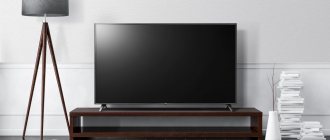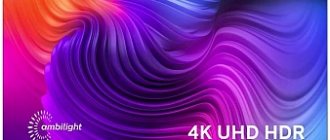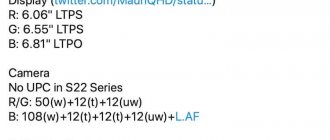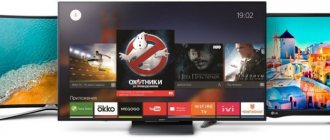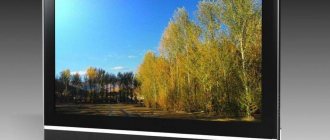He is the king of all living rooms, the love and even addiction of billions of people, a means of entertainment and information. We are talking about TV. The first televisions appeared in the United States back in 1929 and had a screen the size of a postage stamp. In 1942, a television set more reminiscent of modern devices was created in Europe. Evolution took place rapidly, and today flat, large, high-contrast and even smart TVs have become the norm. And it seems that the development of technology is happening before our eyes, but it’s not easy to understand the assortment available. In the store, next to each model, there are a lot of vague abbreviations, numbers and, of course, the price. Sellers are trying to push us to sell us a more expensive TV, and we, not knowing all the intricacies of technology, deliberately allow ourselves to be deceived. It's time to end this. Let's figure out how to choose a TV in 2021 and what parameters are really important to pay attention to. We have also prepared for you a rating of the best TVs of 2021.
LG 49SJ810V
The 2021 TV rating opens with the LG 49SJ810V, a forty-nine-inch unit with Ultra HD resolution and Edge LED backlighting. Progressive scan and refresh rate - 100 Hz. Colors are rendered more colorful and rich thanks to the updated Nano Cell technology. The TV has all digital standards, a good built-in player that allows you to play fairly “heavy” videos in ultra-high 4K resolution. Two built-in 20 W speakers with the ULTRA Surround / Smart Sound enhancement function allow you to enjoy high-quality surround sound. 4 HDMI and 3 USB connectors will allow you to connect any necessary additional equipment to the TV, be it a game console, a multimedia player or a removable hard drive with recorded movies.
Refresh rate, color gamut, HDMI
The refresh rate, which is expressed in Hertz, indicates how many times per second the image on the display is updated. The usual refresh rate is sixty hertz. It is not enough for dynamic moments; the image is interrupted and blurred. To improve the quality of dynamic scenes, manufacturers increased the frequency by 2 times. Certain televisions have a frequency of two hundred and forty hertz. The best option is to purchase a device with a frequency of one hundred and twenty hertz.
The color gamut shows the range of shades that the device is capable of displaying. Most of today's TVs support NTSC, which provides 16,000,000 different colors. Of course, there are devices capable of transmitting 32,000,000 colors, but you are unlikely to feel the difference.
You also need to consider whether the device you are purchasing has HDMI ports. To reduce costs, manufacturers reduce the number of such connectors to 2, sometimes even to one. This is clearly not enough to simultaneously connect an audio system, Blu-ray player and console.
LG 32LH530V
Despite the small diagonal, this TV is one of the most popular in its segment. In the age of the proliferation of digital technologies, many people are more accustomed to using devices without unnecessary bells and whistles. Full HD resolution and LED backlight with Direct LED technology, refresh rate of 60 Hz and viewing angle of 178 degrees. Despite the lack of Smart add-ons, the model offers all decoders (DVB-T/T2, DVB-C, DVB-S/S2), high-quality sound and support for most multimedia formats - from audio (mp3, WMA) to video (Xvid, MKV) . There are USB and 2 HDMI outputs. One of the best budget TVs on the market in 2018.
From 90 thousand rubles
The price for models diagonally larger than 55 inches exceeds 90 thousand rubles. This is not surprising, because to achieve a clear image for this screen size, you will need the most modern and expensive technologies. Therefore, the best models are presented only by the world's leading brands.
1LG OLED55C6V
LG holds the leadership in the most technologically advanced and expensive segment.
This is a model with a 55-inch diagonal curved OLED screen, an ultra-thin body and an almost invisible frame.
The image on it is incredibly detailed and realistic. Here, in addition to the usual functionality, there is 3D technology and 4 speakers with a total power of 40 W, as well as a number of automatic video and sound optimization systems.
Advantages:
- best image quality;
- excellent sound;
- Magic Remote;
- functionality.
No deficiencies found.
The average price is 130 thousand rubles.
Prices for LG OLED55C6V:
2Sony KD-65XD7505
The main advantage of this model is the incredibly large screen diagonal of 65 inches. At the same time, you will fully experience all the delights of 4K high-definition images. If functional bells and whistles are not important to you, then you can safely buy this TV. It has excellent picture and sound, has a Smart TV, satellite and digital receiver and other necessary functions. Unlike the previous model, there is no 3D support, less powerful sound and simpler Direct LED display technology.
Advantages:
- large screen;
- high-quality image;
- good functionality.
No deficiencies found. The average price is 108 thousand rubles.
Prices for Sony KD-65XD7505:
3Samsung UE55JU7500U
The 55-inch model from Samsung completes the list of expensive models. This is a 4K TV with a curved screen, 3D support and a full range of modern features. It is characterized by good color rendition, high contrast, realistic and detailed images. Speakers with a subwoofer with a total power of 40 W create deep surround sound.
Intelligent backlight automatically reduces the intensity in dark areas and increases the intensity in light areas, creating an optimally realistic picture.
Advantages:
- excellent picture and sound;
- functionality;
- convenient setup.
No deficiencies found.
The average price is 98 thousand rubles.
Prices for Samsung UE55JU7500U:
Panasonic TX-50DXR700
The best TVs of 2021 included the Panasonic TX-50DXR700. More than conservative fifty inches and 4K / Ultra HD resolution allowed this model to switch consumer attention from flagships to itself. Mandatory stereo sound with rich bass and an image with a refresh rate index of 1400 Hz. The Smart TV function runs on the My Home Screen operating system, which in turn is based on Mozilla Firefox. Users liked the fast and functional system. The TV can be used for its intended purpose, or as a monitor for a computer with a corresponding variety of choices for the connected screen resolution. Three USB and HDMI outputs, a connector for connecting to a local computer network and a built-in Wi-Fi module will reassure the most skeptical citizens.
Sharp
This is another brand with a hundred-year history; in addition, Sharp was the first brand under whose name the first 4K TV was released. At the moment, the most popular brand of this brand can be considered the 40-inch model LC-40CFG6452E . The smart TV has a resolution of 1920x1080 pixels. It runs on Sharp’s proprietary smart platform – AQUOS NET+, which provides all the standard capabilities of Smart TV.
Sharp LC-40CFG6452E is available today within the range of 11,000-12,400 UAH.
Samsung UE40MU6400
In Russia, TVs from this company, along with the LG brand, are the most popular. In this case, we have forty inches of excellent Ultra HD images. The fairly fast Tizen operating system, as well as connecting the TV to the global network via a built-in Wi-Fi module or network cable, allows you to turn this model into a full-featured player of both audio and video content. Edge LED backlighting, 4300:1 contrast ratio and the widest viewing angle give you the best viewing experience. All kinds of outputs from HDMI and USB, to component, LAN and Bluetooth allow you to manipulate the connection of various multimedia components.
Choosing a TV in 2021
Device Dimensions
Let's start with the simplest. There is an opinion that you should buy as big a TV as your budget allows. Previously, the standard was widespread that the distance from the audience to the screen should be 3-4 diagonals, later they started talking about 2-3 diagonals. Today it is believed that the optimal distance to the screen is a subjective concept , i.e. whoever is comfortable. How to find this optimal value, because a screen that is too small will not convey details, and a screen that is too large will force you to turn your head to see the entire scene?
The best way is to evaluate a TV in a store from the distance at which you will be watching it . So everything will immediately fall into place. And further. The purchase should look harmonious in the room and fit in the place prepared for it, so do not overdo it with the diagonal.
32-55-inch TVs are used for the home ; smaller screens are sometimes placed in the kitchen, and larger ones in spacious living rooms.
Screen resolution
To simplify, screen resolution is the number of pixels placed vertically and horizontally. Pixels make up a picture, so logically speaking, the more pixels the better.
Currently on sale are TVs with the following resolution:
- HD, 1366*768 pixels. This resolution will soon become a thing of history, but for now it is used in the most inexpensive models with a small diagonal. Judge for yourself, if you stretch 1366*768 pixels over a diagonal of 52 inches or more, individual pixels will be clearly visible to the eye, the picture will not be perceived as a whole, and there will be no pleasure in viewing it. It is appropriate to use HD resolution on TVs with screens up to 24 inches;
- FullHD , 1920*1080 pixels. This is the most popular format today, and most media content is produced in FullHD (sometimes HD) resolution. The best choice in terms of price-quality ratio;
- UltraHD or 4K, 3840*2160. This is the future of TVs. Such models are slowly filling store shelves, captivating us with a clearer image.
Which TV is better to choose, with FullHD or 4K resolution ? This is the subject of heated debate online. Defenders of FullHD say that 4K content is still quite scarce, so there is no point in overpaying for another marketing gimmick. In addition, individual points on a FullHD screen with a diagonal of 40 inches cannot be seen by a person even with the sharpest eyesight from a distance of 160 cm. The difference will be visible from a distance of 50-80 cm, and no one watches TV that close, so “why pay more?". Fans of 4K say that there is more and more content in this format: new films, entire YouTube channels and their own videos shot on 4K cameras. And in general, a TV is bought for 5 or more years, it is not cheap, and there is no point in buying outdated technology, because everything around us is rapidly developing, and FullHD will go down in history just like the recently popular plasma TVs.
Optimal distance from the TV depending on its diagonal and resolution
It’s up to you to decide, of course, but we’ll get in with our subjective point of view. If money allows and you want to buy a large-screen TV, then it’s better to stick with 4K. This way you will get a really high-quality image and will not experience any inconvenience for the next few years. If you need a small diagonal TV (24-42 inches) or you are buying a second TV, then feel free to take FullHD. For a kitchen or cottage, a small TV with HD resolution will generally do.
Matrix type
Today the question comes down to choosing between LCD and OLED. The so-called plasma, unfortunately for many, is a thing of the past.
LCD/LED TVs
LCD TVs use a liquid crystal matrix, familiar to us from monitor screens. The simplified principle of operation looks like this. LEDs or lamps create radiation, and liquid crystals partially or completely block the light source to form a color of a certain contrast. LCD matrix can be of several types: IPS is better than TN + film , but worse than VA. The backlight can also be arranged in different ways. There are CCFL (backlight lamps) and LED technology (based on diodes). The latter made it possible to improve color rendition and reduce the thickness of the TV, and today it is used everywhere, which is why LCD TVs are often called LED TVs .
Backlighting in LCD/LED TVs can be of two types:
- direct Backlight LED ( DirectLED ). The backlight is located behind the LCD matrix, allowing you to more evenly illuminate the entire plane of the screen and organize high-quality local dimming, which is used in HDR mode
- contour Edge LED. LEDs are located along the contour of the screen, and a clever reflector system allows the illumination to spread across the entire display. This is a cheaper technology.
Many manufacturers believe that LCD/LED technology is the future and are actively developing it. The advantages of such TVs :
- low price (compared to OLED technology);
- small thickness, light weight, minimal energy consumption;
- high brightness of screens;
- long service life;
- The development of technology, the emergence of quantum dot backlighting and other innovations that improve image quality make LCD TVs comparable to OLED, but this affects the price increase.
Minuses:
- The black color looks like a dark gray, which is especially noticeable when the room is dark. All this is due to the nature of the technology;
- relatively long response time, so in dynamic scenes a trail from previous scenes may be visible, but today such an effect is rare;
- When viewed from the side, color and contrast may be distorted.
OLED TVs
The most modern TVs. The image here is obtained thanks to a matrix with organic light-emitting diodes. They are tiny elements created from light-emitting organic materials. No third-party backlight is required, so we can talk about the possibility of creating very thin screens and transmitting deep black colors. To display it, the LED simply turns off and does not emit light.
Advantages of the technology:
- correct black color;
- high contrast, excellent color rendition;
- wide viewing angles;
- instant response.
The main disadvantage is the high price . Many users note that in bright sunlight the picture on the screen becomes less visible, and the contrast of an inept manufacturer can turn into acidity.
So which TV is better to choose? If you have a sufficient budget for the purchase and are pursuing the goal of taking everything that is the most modern and technologically advanced, then it is better to stop at OLED. If funds are limited, feel free to opt for an LCD screen - this technology also performs very well, and the average viewer will not experience any particular inconvenience.
Where did plasma TVs go?
Many people still call flat-panel TVs "plasma". This is due to the fact that the technology was previously incredibly popular. Today such devices are no longer produced. Among the main reasons for abandoning the technology are high power consumption, low brightness and the inability to create a screen with a small diagonal. On the other hand, many still consider plasma TVs to be the best.
In short, such screens consisted of many cells filled with inert gas. When a certain voltage was applied, the gas turned into a plasma state and began to glow. The light passed through a camera coated with a phosphor of one of the main shades (RGB) - this is how the image was obtained. It was praised for its natural color reproduction, soft light, wide viewing angles, rich blacks and high refresh rate, so dynamic scenes on such screens went with a bang. One of the disadvantages, in addition to those already mentioned above, is the residual image when playing a static picture for a long time. Since plasma cells are relatively large, it is impossible to create a small TV with a high diagonal - “plasmas” started from a diagonal of 42 inches.
Frequency
Frequency is the number of times an image is updated in 1 second. The parameter is measured in Hz. You should focus on the 60 Hz parameter - the human eye will still not be able to catch anything more, so a frequency of 100 Hz will not become a competitive advantage, all other things being equal. If you are going to watch 3D video, then the frequency should be 120 Hz - 60 Hz for each eye.
Flat and curved screens
When there was nothing left to surprise, manufacturers began making TVs with curved screens. Today, “curved” TVs are usually produced by the most modern TV sets in terms of technical parameters – those with 4K resolution. According to the manufacturers, such a screen should increase the realism of scenes and make the viewer part of what is happening. In addition, the developers of this solution say that a curved device visually appears larger than a straight one with the same diagonal. Some weak advantages, given the fact that curved TVs are much more expensive than their ordinary flat counterparts.
In addition to the price, the disadvantages of curved TVs include a reduced viewing angle , because you can watch movies comfortably only if you sit directly in front of the screen. It will be more difficult for a large company. A TV with a diagonal of 55-70 inches will comfortably be viewed only 35 degrees in each direction from the center, but even a diagonal of 70 inches is not capable of creating the much-advertised immersion effect. If these cons don't bother you and you like the really cool futuristic look of curved screens, then prepare a hefty sum and keep in mind that you can't hang such a panel on the wall.
Sound
It is difficult to integrate a powerful sound system into a thin, light modern TV, so most have mediocre sound. This is enough for watching television. What can I say, movies and music are also reproduced perfectly on such devices. But if you want the sound to be perfect, loud, clear and create an effect like in a cinema, then it is better to buy several speakers that will be combined into a home theater system.
We also note that expensive TV models have a fairly decent built-in sound system.
HDMI ports
If you plan to use the TV not only for watching TV channels, but will connect players, game consoles or TV consoles, then there should be a lot of HDMI ports - at least 3. Calculate in advance which peripheral devices will be connected to the TV.
Read our article Smart TVs. How to choose a smart TV
Brightness, contrast, viewing angles
In the description of the TV you can find the following parameters:
- contrast. Shows how much brighter the white areas of the screen are than the black areas, expressed as a ratio such as 1000:1. For LED TVs this figure is low, for OLED it is much higher. Good contrast can be said at a ratio of 5000:1, but many models use dynamic contrast, when the screen brightness is adjusted depending on the frame;
- brightness – luminous intensity per square meter, cd/m2. The screen must have sufficient brightness so that the image does not fade under bright sunlight and does not strain your eyesight. Too high a brightness may result in loss of contrast. Inexpensive TVs have a brightness of up to 300 cd/m2, more expensive models have a brightness of about 400 cd/m2, and the most expensive ones have a brightness of up to 600 cd/m2;
- The viewing angle on modern TVs reaches 170-180 degrees;
- Response time tells how long it takes a pixel to move from one state to another. The shorter the time period, the better dynamic scenes will look. For normal transmissions, a response of 8-10 ms is sufficient; in the most modern models this parameter is 2-5 ms.
Additional features: Smart TV, 3D, HDR and others
Many TVs come with a whole range of additional features:
- Smart TV. This TV has an operating system with built-in applications for viewing content from YouTube and other sources. The device receives Internet via a Wi-Fi module or thanks to an Internet cable that is inserted into the RJ-45 connector. Different manufacturers use their own operating systems. Sony and Philips have Android TV, LG has WebOS. A TV with built-in Smart TV is more expensive than a regular TV. To save money, you can buy a regular TV and a set-top box for it, on which you can install any applications. This set-top box costs from $30. The price depends on the capabilities. The main thing is that it supports video playback in a resolution no lower than the TV itself. And, yes, it will take some time to connect and configure, but in principle it’s not difficult to figure out;
- 3D _ Today the technology is no longer as popular as it used to be. Such TVs allowed viewing three-dimensional content. Active 3D technology requires glasses with LCD shutters (they are quite expensive); for passive 3D technology, simple polarized glasses are suitable;
- HDR, extended dynamic range. The technology allows you to show more shades in shaded or overly lit areas. For good HDR performance, you need a powerful processor, high brightness and the presence of HEVC and VP9-Profile2 decoders. In descriptions for various models, the HDR function may be indicated as HDR10, HDR10+, Dolby Vision, HLG.
You should not pay much attention color gamut indicators In the store, judge for yourself the quality of the image and the ability to customize it, but there are practically no problems with color distortion now.
Important! Check for dead pixels . To do this, just fill the screen with one color (green, blue or red will do) and carefully examine at close range whether all the dots convey this color. You can bring the image with you on a flash drive, but many TVs have ready-made images for testing.
LG 55UK6100
A fairly popular TV in 2021, both among experts who never tire of praising its merits, and among brand buyers. The ability to view content in 4K resolution attracts the attention of many, especially since its availability is growing every day on stream services and online video portals. The webOS operating system is considered by many to be much more convenient than conventional Android offerings. A brightness of 200 cd/m2 and a contrast ratio of 1200:1 allows this 55-inch TV to give the user a full-fledged rich picture, and good built-in speakers provide excellent sound. The usual ones for such cases are HDMI (three), USB (two) and RJ-45 for connecting to a home network.
Sound system
Even the most modern devices can have poor sound quality. This is due to the small thickness of televisions. There is simply no room in the case to integrate full-fledged speakers into it.
There are three ways to solve this problem:
- Buy headphones (the best option if the device has 1 viewer).
- Buy a stereo system.
- Buy an audio panel or acoustic system.
If you watch regular television, you can use standard speakers. If you want to enjoy high-quality, clear sound when watching a movie or a football match, then you need to buy additional audio equipment.
Samsung UE65JS9500
In the middle of the ranking of the best TVs of 2021 is the Samsung UE65JS9500. It is a pleasure to watch, especially thanks to the curved screen and the ability to convert a regular image into a three-dimensional (3D) image. As for the sound, as many as four speakers are responsible for it, delivering a power of 60 W (two of 20 and two of 10), which is especially noticeable when watching Hollywood blockbusters. Two independent TV tuners and the ability to view video content in the original settings - the “24p True Cinema” function. As many as 4 HDMI outputs do not limit the owner in connecting various peripherals, which is facilitated by additional 3 USB connectors, a network output and a built-in Wi-Fi module. Among the main features of the TV are gesture or speech control functions.
Curved displays, Smart TV
Curved screens were originally designed to attract consumers' attention. They are usually used in OLED devices. Such screens make watching TV exciting and unusual, giving new sensations.
However, such displays do not have any technical advantages over ordinary ones and have certain disadvantages. For example, due to curvature, the viewing angle is significantly reduced. This may cause inconvenience when watching TV with multiple viewers sitting in a row. In addition, the brightness of the picture may vary in different areas of the screen. It is better to purchase a TV with a regular flat-panel display.
Smart TV allows you to connect your device to the Internet. Today, this function is present in almost any TV model and is considered mandatory. It is especially often used to watch videos posted on YouTube on a large screen.
Philips 55PUS7600
The Philips 55PUS7600 is an excellent TV from the Netherlands that offers competitive 4K and thirty-watt Dolby Digital surround sound. The ability to convert any video content into a three-dimensional format. On board the TV is the Android TV operating system, which, in combination with a connection to a global network (Wi-Fi or LAN), allows the owner to expand the capabilities of his TV into a multimedia center with indispensable video or audio content from all over the world. There is a special jack for connecting headphones so you can watch or listen to materials without disturbing other family members. Among the special functions of the TV, I would like one that allows you to pause the broadcast of a television channel at any time with the function of recording and further viewing from the moment it was stopped.
Rating of manufacturers of inexpensive TV models by quality
Many manufacturers make several product lines for every budget in order to offer customers a choice in different segments and have a large market share. But there are still companies that are better at making expensive models, and there are those that have been successfully producing affordable, good quality TVs for many years. In the first positions on the list will be those who are aimed at buyers with low and middle incomes, and below those who sometimes produce cheap ones among their main products.
- Philips;
- Supra;
- Thomson;
- BBK;
- Panasonic;
- Samsung;
- Hyundai;
- LG.
Sony KD 43X8305C
Opens the top three best TVs Sony KD 43X8305C. It has more than a meter diagonally and Ultra HD resolution. Image refresh rate index from 800 Hz, Edge LED backlight. Many TV decoders from DVB-T2 to DVB-C, and for those who like to choose what to watch on their own, a local network connection, Wi-Fi or multiple choice of connecting additional multimedia devices via HDMI or USB outputs. Support for the “CI+” and “24p True Cinema” functions - paid decoding and the ability to view video content at 24 frames per second.
Customer Reviews
Nikolay Kondratyev
Before choosing, I always analyze everything, consult in stores and with friends who have already purchased, and only then make a decision. After all, advertising does not always tell the truth, and prices can vary significantly at different retail outlets.
Arthur Knyazkov
The smartest people always look for the lowest price and then order. Some people read reviews of those who bought them under each product, but everyone’s taste is different and their needs are different, so it’s possible to make a bad purchase. I like to first study all the parameters and read what they write about it, otherwise now there are a lot of new technologies that even consultants cannot always clearly explain - what is the essence and how necessary they are.
How do you like the article?
Panasonic TX-50DXR700
A smart TV with a diagonal of fifty inches and Ultra HD resolution. Progressive scanning and an image refresh rate index of 1400 Hz give the TV indescribable image reproduction capabilities. At the same time, well-made two built-in 10 W speakers complement the comfort of viewing a variety of content. 3 HDMI and the same number of USB outputs, local wired and wireless computer network, optical and component output - all this will allow owners to expand the functionality of the TV. Convenient placement on surfaces using durable “legs”, or mounting to the wall using specialized brackets.
About the benefits and harms of 4K
The 4K format has gradually ceased to be exotic and has penetrated even into the middle segment. Today you have a great chance of buying a 4K TV if your budget reaches 50,000 rubles. However, is it worth pursuing this so much?
The fact is that if you watch mainly terrestrial or digital television (cable, satellite, IPTV), then the local signal, which has a maximum of 1080 lines, will be scaled exactly 4 times to the “native” resolution of the TV. Losses cannot be avoided, and the picture will seem more “soapy” than in the original. That is, you will not be able to feel any special advantages, and in this case it is enough to choose a TV with Full HD resolution.
If you plan to actively watch movies and TV series, play on modern consoles or a powerful PC, then buying a 4K TV becomes completely justified. Moreover, pay attention to HDR support - you will need it at a much higher resolution. With so much content now being shot in 4K and being polished for release in 4K HDR, the shortage has been left behind.
Samsung QE49Q7CAMU
Our rating of “ Top 10 best TVs of 2018 ” is headed by Samsung QE49Q7CAMU. Rich 4K color reproduction is achieved with the help of a curved screen that produces a brightness of 1500 cd/m2. Four ten-watt speakers allow you to experience all the vicissitudes of the sound. Multimedia content is possible both through an external connection (HDMI, USB, Wi-Fi, home local network) and when using the Smart TV function, built on the Android operating system. The TV allows you to view or listen to video and audio in all popular formats, as well as display photographs (images) in JPG format. For those who prefer the broadcast network of regular TV channels, the unit gives them the right to use it with all comfort, thanks to the built-in decoders.
You have already voted
Hitachi
Despite the fact that few people have heard the name of this brand, nevertheless, the Japanese brand Hitachi has a century-old history, and many Ukrainian consumers prefer it when choosing smart TVs. For example, model 32HB4T62 , this 32-inch smart TV not only has a relatively small screen, but also a fairly low price. It runs on the SmarTVue smart system. You can control the TV either through a smartphone and the Hitachi Smart Remote mobile application, or using a regular remote control.
You can buy Hitachi 32HB4T62 at prices ranging from 7,823 to 8,235 UAH.
